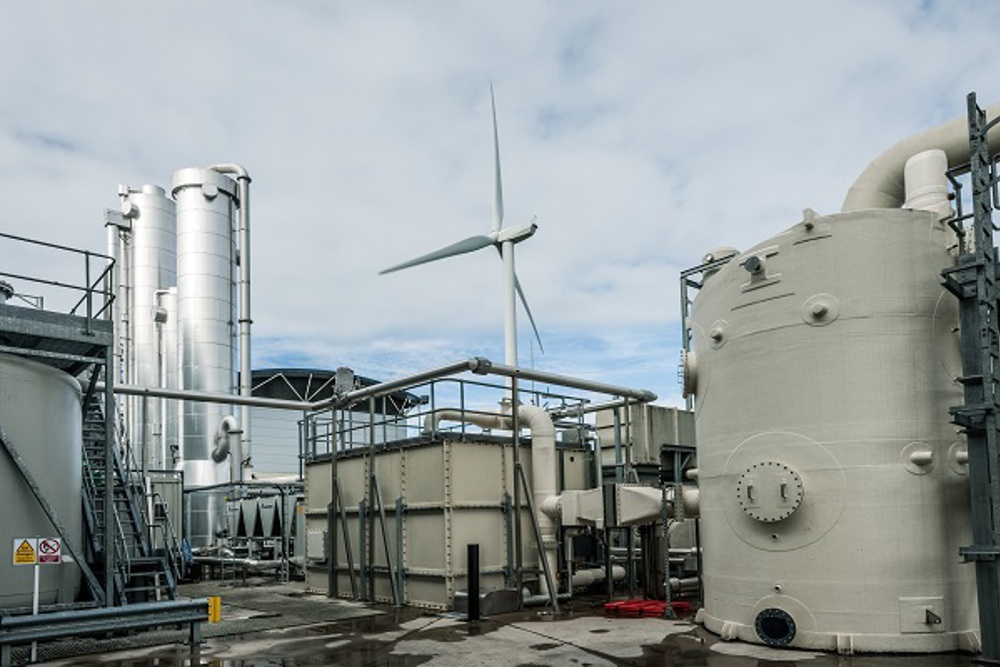Biomethane
Make sure waste isn't wasted
About biomethane
Biomethane has the same composition as methane derived from fossil fuels and can be used as a substitute for natural gas.
Biomethane is produced at Bristol sewage treatment works by upgrading biogas produced from anaerobic digestion - a completely natural process in which micro-organisms break down biodegradable material in the absence of oxygen.
"Biomethane is the fuel of the future, but it's here now. By using renewable gas generated from food and sewage waste, we are putting the circular economy into action."
The raw fuel
The raw fuel for this process comes from your waste. Biogas is produced by organic matter in sewage sludge, liquid waste and inedible food waste.
56,000m3
The amount of biogas we produce daily at Bristol sewage treatment works - that's equivalent to the methane produced daily by all the dairy cows in Wales!
The biogas produced in our digesters undergoes processing in our gas to grid plant to convert it into enriched biomethane.
Biomethane can be used as a direct substitute for natural gas in homes and vehicles - it is a sustainable and renewably-sourced alternative to fossil fuels.
Gas to grid
Gas to grid plant
The gas to grid plant at Bristol sewage treatment works is the first and largest of its kind. The plant produces up to 1,900m3/hr of enriched biomethane by cleaning and upgrading methane-rich biogas produced from the anaerobic digestion of waste.
Biomethane is used as a renewably sourced and sustainable substitute for natural gas in our local distribution network across Bristol. We supply the national grid with enough gas to supply thousands of local homes and ensure our sewage treatment works is energy self-sufficient.
How it works
- Sewage sludge and food waste is treated and pumped into a series of anaerobic digesters. The waste is heated to 32 - 42°C and kept in the digesters for 12 to 18 days. During this time, micro-organisms break down the biodegradable material in the absence of oxygen to produce methane rich biogas. At this point, the biogas contains around 60% methane.
- The biogas produced from the digesters then enters the gas to grid plant. The first stage upgrades the biogas to biomethane (~98%; 1.5% nitrogen).
- A bioscrubber removes gaseous impurities, such as carbon dioxide and hydrogen sulphide. Meanwhile the carbon filters produce virtually odour free emissions to the air.
- A small volume of propane is injected into the biomethane. This enriches the gas to natural gas quality and calorific value.
- The end product, enriched biomethane, is analysed and undergoes strict quality controls before being fed into the local gas distribution network.

Green Gas Certificates
GENeco's gas to grid facility is registered with the Green Gas Certification Scheme (GGCS), a system that tracks biomethane, or 'green gas', through the supply chain to provide certainty for those that buy it.
Each unit of biomethane injected into the grid displaces a unit of conventional gas. Each kWh of biomethane is labelled electronically with a unique identifier known as a Renewable Gas Guarantee of Origin (RGGO). This identifier contains information about where, when and how the green gas was produced. When consumers buy green gas the RGGO is their guarantee that the gas is authentic and has not been sold to anyone else. It ensures there is no double-counting from production to end use.
The globally-recognised GHG Protocol has recently recognised that Green Gas Certificates, issued by the Green Gas Certification Scheme (GGCS), can support a business's reporting of onsite GHG emissions, and lead to near-zero greenhouse gas emissions reporting.
If you wish to discuss any aspect of GENeco's Green Gas Certificates, please get in touch.
Environmental benefits
The integration of enriched biomethane into the national gas grid has several key environmental benefits.
The carbon dioxide released by combustion of biomethane does not increase atmospheric CO2 ; this is because the same amount of CO2 is produced from natural decomposition of the organic matter that initially creates the biomethane.
In contrast, the CO2 released from the burning of fossil fuels (such as natural gas) has been locked up in geological formations for millions of years, and would not otherwise be released to the atmosphere.
Furthermore, the greenhouse gas effect of methane produced from sewage sludge is 21 times more powerful than CO2. Therefore, the capturing of this methane and combustion as part of the national gas supply significantly reduces the environmental impact of our operations.
The gas to grid plant diverts inedible food waste from landfill, with this type of waste producing twice as much biogas as sewage sludge.
